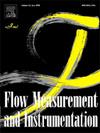振动条件下涡轮流量计的性能补偿模型
IF 2.3
3区 工程技术
Q2 ENGINEERING, MECHANICAL
引用次数: 0
摘要
振动条件会影响涡轮流量计的性能,导致测量结果不准确或不稳定。本文以 DN10 涡轮流量计为例,研究振动条件对涡轮流量计性能的影响规律。建立了一个实验设施来模拟振幅从 35 毫米到 90 毫米、频率从 0 赫兹到 4 赫兹的振动条件。提出了一种基于动态坐标系和 6DOF(六自由度)的涡轮流量计振动条件下的模拟方法。基于实验和 CFD(计算流体动力学)仿真,结果表明涡轮流量计在振动条件下的平均流量计因数大于非振动条件下的平均流量计因数。平均流量计因数随振动幅度和振动频率的增加而增大。测量流量的最大相对误差为 9.73%。为了减小测量误差,提出了涡轮流量计在振动条件下的性能补偿模型。流量计系数增量为因变量,频率、振幅和流量为自变量。结果表明,与原始模型相比,采用补偿模型的涡轮流量计的相对误差平均减少了 76.61%。本文章由计算机程序翻译,如有差异,请以英文原文为准。
Performance compensation model of turbine flowmeter under vibration conditions
Vibration conditions will affect the performance of the turbine flowmeters, resulting in inaccurate or unstable measurement results. A DN10 turbine flowmeter is taken as an example to study the influence rule of vibration conditions on the turbine flowmeter performance. An experimental facility is built to simulate the vibration conditions with amplitude ranging from 35 mm to 90 mm and frequency ranging from 0 Hz to 4 Hz. A simulation method for simulating a turbine flowmeter under vibration conditions based on a dynamic coordinate system and 6DOF (Six Degrees of Freedom) is proposed. Based on the experiments and CFD (Computational Fluid Dynamics) simulation, the results show that the average meter factor of the turbine flowmeter under vibration conditions is larger than that under non-vibration conditions. The average meter factor increases with vibration amplitude and vibration frequency. The maximum relative error of the measured flow rate is 9.73 %. To reduce the measurement error, a performance compensation model of the turbine flowmeter applied to vibration conditions is proposed. The meter factor increment is taken as the dependent variable, and the frequency, amplitude, and flow rate are taken as independent variables. The results show that compared to the original model, the relative error of the turbine flowmeter with the compensation model shows an average reduction of 76.61 %.
求助全文
通过发布文献求助,成功后即可免费获取论文全文。
去求助
来源期刊

Flow Measurement and Instrumentation
工程技术-工程:机械
CiteScore
4.30
自引率
13.60%
发文量
123
审稿时长
6 months
期刊介绍:
Flow Measurement and Instrumentation is dedicated to disseminating the latest research results on all aspects of flow measurement, in both closed conduits and open channels. The design of flow measurement systems involves a wide variety of multidisciplinary activities including modelling the flow sensor, the fluid flow and the sensor/fluid interactions through the use of computation techniques; the development of advanced transducer systems and their associated signal processing and the laboratory and field assessment of the overall system under ideal and disturbed conditions.
FMI is the essential forum for critical information exchange, and contributions are particularly encouraged in the following areas of interest:
Modelling: the application of mathematical and computational modelling to the interaction of fluid dynamics with flowmeters, including flowmeter behaviour, improved flowmeter design and installation problems. Application of CAD/CAE techniques to flowmeter modelling are eligible.
Design and development: the detailed design of the flowmeter head and/or signal processing aspects of novel flowmeters. Emphasis is given to papers identifying new sensor configurations, multisensor flow measurement systems, non-intrusive flow metering techniques and the application of microelectronic techniques in smart or intelligent systems.
Calibration techniques: including descriptions of new or existing calibration facilities and techniques, calibration data from different flowmeter types, and calibration intercomparison data from different laboratories.
Installation effect data: dealing with the effects of non-ideal flow conditions on flowmeters. Papers combining a theoretical understanding of flowmeter behaviour with experimental work are particularly welcome.
 求助内容:
求助内容: 应助结果提醒方式:
应助结果提醒方式:


